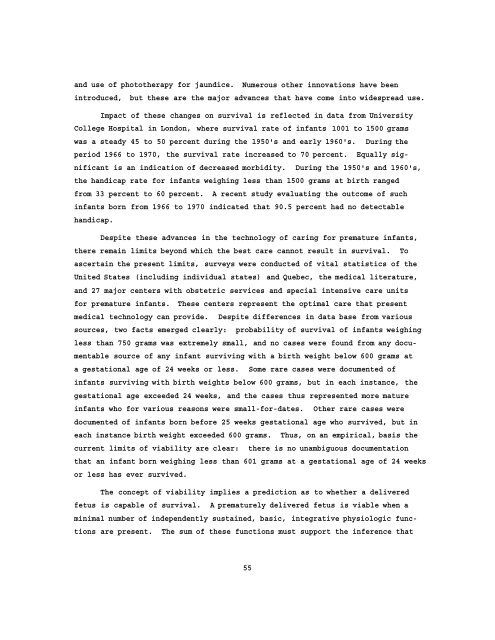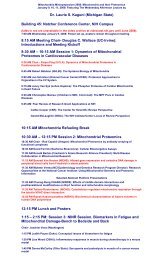RESEARCH ON THE FETUS - National Institutes of Health
RESEARCH ON THE FETUS - National Institutes of Health
RESEARCH ON THE FETUS - National Institutes of Health
You also want an ePaper? Increase the reach of your titles
YUMPU automatically turns print PDFs into web optimized ePapers that Google loves.
and use <strong>of</strong> phototherapy for jaundice. Numerous other innovations have been<br />
introduced, but these are the major advances that have come into widespread use.<br />
Impact <strong>of</strong> these changes on survival is reflected in data from University<br />
College Hospital in London, where survival rate <strong>of</strong> infants 1001 to 1500 grams<br />
was a steady 45 to 50 percent during the 1950's and early 1960's. During the<br />
period 1966 to 1970, the survival rate increased to 70 percent. Equally significant<br />
is an indication <strong>of</strong> decreased morbidity. During the 1950's and 1960's,<br />
the handicap rate for infants weighing less than 1500 grams at birth ranged<br />
from 33 percent to 60 percent. A recent study evaluating the outcome <strong>of</strong> such<br />
infants born from 1966 to 1970 indicated that 90.5 percent had no detectable<br />
handicap.<br />
Despite these advances in the technology <strong>of</strong> caring for premature infants,<br />
there remain limits beyond which the best care cannot result in survival. To<br />
ascertain the present limits, surveys were conducted <strong>of</strong> vital statistics <strong>of</strong> the<br />
United States (including individual states) and Quebec, the medical literature,<br />
and 27 major centers with obstetric services and special intensive care units<br />
for premature infants. These centers represent the optimal care that present<br />
medical technology can provide. Despite differences in data base from various<br />
sources, two facts emerged clearly: probability <strong>of</strong> survival <strong>of</strong> infants weighing<br />
less than 750 grams was extremely small, and no cases were found from any documentable<br />
source <strong>of</strong> any infant surviving with a birth weight below 600 grams at<br />
a gestational age <strong>of</strong> 24 weeks or less. Some rare cases were documented <strong>of</strong><br />
infants surviving with birth weights below 600 grams, but in each instance, the<br />
gestational age exceeded 24 weeks, and the cases thus represented more mature<br />
infants who for various reasons were small-for-dates. Other rare cases were<br />
documented <strong>of</strong> infants born before 25 weeks gestational age who survived, but in<br />
each instance birth weight exceeded 600 grams. Thus, on an empirical, basis the<br />
current limits <strong>of</strong> viability are clear: there is no unambiguous documentation<br />
that an infant born weighing less than 601 grams at a gestational age <strong>of</strong> 24 weeks<br />
or less has ever survived.<br />
The concept <strong>of</strong> viability implies a prediction as to whether a delivered<br />
fetus is capable <strong>of</strong> survival. A prematurely delivered fetus is viable when a<br />
minimal number <strong>of</strong> independently sustained, basic, integrative physiologic functions<br />
are present. The sum <strong>of</strong> these functions must support the inference that<br />
55











